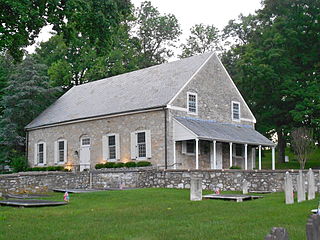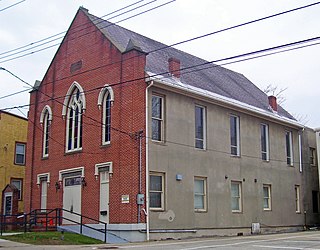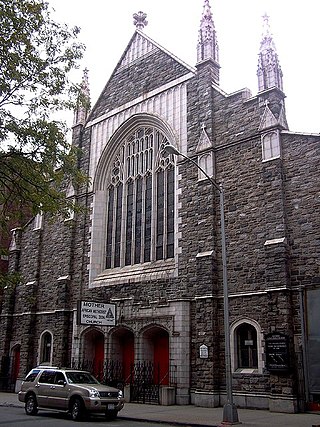
Paxtang is a borough in Dauphin County, Pennsylvania, United States. As of the 2020 census it had a population of 1,640. The borough is a suburb of Harrisburg and is one of the earliest colonial settlements in South Central Pennsylvania.

Rev. Jermain Wesley Loguen, born Jarm Logue, in slavery, was an African-American abolitionist and bishop of the African Methodist Episcopal Zion Church, and an author of a slave narrative.

Camp Curtin is a historic neighborhood in Harrisburg, Pennsylvania's northern end, located in Uptown and named for the American Civil War camp of the same name. It is bordered currently by landmarks of Fifth Street to the west, the railroad tracks next to the Pennsylvania Farm Show Complex to the east, Maclay Street to the south, and Reels Lane to the North.

Harriet Tubman National Historical Park is a US historical park in Auburn and Fleming, New York. Associated with the life of Harriet Tubman, it has three properties: the Harriet Tubman Home for the Aged, in Auburn; the nearby Harriet Tubman Residence, just across the city/town line in Fleming; and the Thompson A.M.E. Zion Church in Auburn. They are located at 180 and 182 South Street and 90 Franklin Street, respectively. The Zion Church unit is administered by the National Park Service (NPS), and the South Street properties, including a historic barn and a visitor center, are jointly managed and operated by both the NPS and the Harriet Tubman Home, Inc. The church also works with the NPS in park operations. The Harriet Tubman Grave, in nearby Fort Hill Cemetery, is not part of the park.

The Foster Memorial AME Zion Church is located on Wildey Street in Tarrytown, New York, United States. Formed in 1860, it is the oldest black church in Westchester County and possibly one of the oldest in the state. During the Civil War it was a stop on the Underground Railroad. One of the church's founders was herself an escaped slave, as were many parishioners. They helped slaves either continue to Canada or settle in Tarrytown if they wished. The church has played a major role in Tarrytown's African-American community ever since.
Thomas James (1804–1891) had been a slave who became an African Methodist Episcopal Zion minister, abolitionist, administrator and author. He was active in New York and Massachusetts with abolitionists, and served with the American Missionary Association and the Union Army during the American Civil War to supervise the contraband camp in Louisville, Kentucky. After the war, he held national offices in the AME Church and was a missionary to black churches in Ohio. While in Massachusetts, he challenged the railroad's custom of forcing blacks into second-class carriages and won a reversal of the rule in the State Supreme Court. He wrote a short memoir published in 1886.

Bethel AME Church, now known as the Central Pennsylvania African American Museum, is a historic African Methodist Episcopal church at 119 North 10th Street in Reading, Berks County, Pennsylvania. It was originally built in 1837, and is a 2½-storey brick and stucco building with a gable roof. It was rebuilt about 1867–1869, and remodeled in 1889. It features a three-storey brick tower with a pyramidal roof topped by a finial. The church is known to have housed fugitive slaves and the congregation was active in the Underground Railroad. The church is now home to a museum dedicated to the history of African Americans in Central Pennsylvania.

Wesley A.M.E. Zion Church is an historic church, which is located at 1500 Lombard Street in Philadelphia, Pennsylvania. Added to the National Register of Historic Places in 1978, it also appears in the Philadelphia Register of Historic Places and the Pennsylvania State Historic Resource survey.

The Mother African Methodist Episcopal Zion Church, also known as "Mother Zion", located at 140–148 West 137th Street between Adam Clayton Powell Jr. Boulevard and Lenox Avenue in the Harlem neighborhood of Manhattan, New York City, is the oldest African-American church in New York City, and the "mother church" of the African Methodist Episcopal Zion conference.
The Greater Hood Memorial AME Zion Church was the first black church in Harlem, New York. It now receives notoriety as the "Oldest Continuing" church in Harlem. The church’s first house of worship was erected on East 117th Street, between 2nd and 3rd Avenues in 1843.
St. David African Methodist Episcopal Zion Cemetery is a historic cemetery located in the Eastville community of Sag Harbor, New York. It is anchored by the AME church, the Eastville Historical Society House on NY 114 and the St. David Cemetery. The site has around 100 graves, including that of Reverend J. P. Thompson, the first pastor of the St. David AME Zion Church.
Abbie K. Mason was a Black American suffragist. She was known as the president of the Woman's Christian Temperance Union (WCTU) and taught the lessons of Fredrick Douglass at the Memorial African Methodist Episcopal Zion Church of Rochester, New York.

The A.M.E. Zion Church of Kingston is an African Methodist Episcopal Zion Church located in Kingston, New York. Founded in 1848, as a land grant from wealthy Black residents, Mrs. Sarah-Ann Hasbrouck and her husband, Alexander, it is the oldest continuous African-American congregation in Kingston and Ulster County. The church is located at 26 Franklin Street in the city's Fourth Ward.

Bishop Singleton T. Jones was a religious leader in the African Methodist Episcopal Zion Church. When he was ten years old, he was apprenticed to a lawyer and worked for him for four years, after which he found positions at an inn, as a hod carrier, and on a riverboat on the Ohio River. He became a pastor in the 1840s, serving churches throughout Pennsylvania, New Jersey, Maryland, and the District of Columbia. Although he had little education, he taught himself to be an articulate orator. Besides being a pastor to churches, he also edited AME Zion publications, the Zion's Standard and Weekly Review and the Discipline.
Rev. John E. Price was an elder and minister of the African Methodist Episcopal Zion Church. He was a minister for around 50 years. He was the founder and president of the Garnet Equal Rights League at Harrisburg. He wrote hymns and was an editor for the Zion Church Advocate and, with William H. Day, the Zion Church Herald and Outlook, the first paper of the AME Zion Church. Day was a minister, abolitionist, and educator.
Lincoln Cemetery was founded in November 1877 by the Wesley Union African Methodist Episcopal Zion Church, and is located at 201 South 30th Street in the Penbrook area of Harrisburg, Pennsylvania.

Harriet McClintock Marshall was a conductor on the Underground Railroad whose home in Harrisburg, Pennsylvania served as a stop or safe house for the clandestine network, along with the Wesley Union African Methodist Episcopal Zion Church and other homes in the city. She offered shelter, food, and clothing to people escaping slavery.

The Underground Railroad in Harrisburg, Pennsylvania was a critical hub of the American Underground Railroad network, which helped men, women and children to escape the system of chattel slavery that existed in the United States during the nineteenth century.













